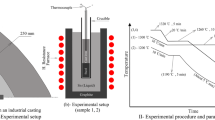Conclusions
-
1.
The depth of penetration of aluminum is considerably larger than that of chromium and silicon.
-
2.
The aluminum concentration must be reduced in order to avoid formation of a superstructure, which leads to brittleness of the diffusion coating.
-
3.
The depth of penetration of the reagents is substantially larger when the gaseous phase is formed directly in the saturation chamber.
Similar content being viewed by others
Literature cited
M. Hansen and K. Anderko, Constitution of Binary Alloys, McGraw-Hill, New York (1958).
A. D. Le Claire et al., Diffusion in BCC Metals [Russian translation], Metallurgiya, Moscow (1969).
Additional information
People's Republic of Bulgaria. Translated from Metallovedenie i Termicheskaya Obrabotka Metallov, No. 8, pp. 20–22, August, 1975
Rights and permissions
About this article
Cite this article
Gogachev, I., Pushev, G. Multicomponent diffusion saturation of low-carbon steels in gaseous media. Met Sci Heat Treat 17, 659–661 (1975). https://doi.org/10.1007/BF00664311
Issue Date:
DOI: https://doi.org/10.1007/BF00664311




